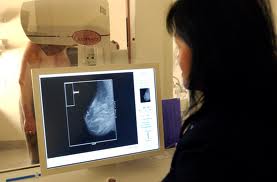Study Suggests Breast Cancer Overdiagnosed
Action Points
- This study examined trends from 1976 through 2008 in the incidence of early-stage breast
 cancer (ductal carcinoma in situ and localized disease) and late-stage breast cancer (regional and distant disease) among women 40 years of age or older.
cancer (ductal carcinoma in situ and localized disease) and late-stage breast cancer (regional and distant disease) among women 40 years of age or older.
- The investigators interpret the data to suggest that there is substantial overdiagnosis, accounting for nearly a third of all newly diagnosed breast cancers, and that screening is having, at best, only a small effect on the rate of death from breast cancer.
As a result of mammographic screening programs, as many 1.3 million women over age 40 were overdiagnosed with breast cancer over three decades, researchers reported.
In a study that seems certain to generate controversy , the researchers concluded that overdiagnosis is involved in up to a third of all newly discovered tumors and that screening plays only a small role in reducing breast cancer mortality.
Over the past 30 years, mammogram programs have increased the detection of early-stage breast cancer, according to Archie Bleyer, MD, of Oregon Health and Science University in Portland and H. Gilbert Welch, MD, of Dartmouth University in Hanover, N.H.
But screening had little effect on the detection of late-stage disease, they reported in the Nov. 22 issue of the New England Journal of Medicine, implying that many women underwent treatment for early forms of cancer that would never have caused serious disease.
.The researchers used a 3-year period near the beginning of the database – 1976 though 1978 – to develop baseline incidence estimates for breast cancer among women 40 and over.
They estimated current incidence using the 3 years from 2006 through 2008. For calculations that covered all 3 decades, they adjusted the observed incidence from 1990 through 2005 to account for increases attributed to the use of hormone replacement therapy over that period.
Finally, their main assumption about the change in background incidence over time among women over 40 was that it would parallel what was seen among younger women – an increase of 0.25% a year.
In 2006-2008, they found, the incidence of early-stage cancer was markedly higher than before screening in 1976-1978, while the incidence of late-stage disease changed minimally.
They found that, annually, there were:
- 7 cases per 100,000 women of ductal carcinoma in situ in the early period, compared with 56 per 100,000 more recently
- For localized disease, 105 per 100,000 women in 1976-1978 and 178 per 100,000 in 2006-2008
- For regional disease, 85 per 100,000 women in the earlier period and 78 per 100,000 in the later period
- 17 cases of distant disease per 100,000 women in both periods
When the figures were rounded off, Bleyer and Welch reported, there were an extra 122 early cases per 100,000 women detected in the mammogram period and a drop of eight cases of late-stage disease.
“With the assumption of a constant underlying disease burden, only 8 of the 122 additional early-stage cancers diagnosed were expected to progress to advanced disease,” they argued.
In 2008, that would have amounted to overdiagnosis in 70,000 women, or about 31% of all diagnosed breast cancers, they reported.
For his part, Bleyer said he’s convinced that the assumptions in the study are conservative and that doctors and patients need to be aware of the harm associated with overdiagnosis as well as any potential benefit from early diagnosis.
The remedy, Bleyer told, would be to reduce the scope of mammographic screening in line with the 2009 recommendations of the U.S. Preventive Services Task Force.
The panel recommended against routine screening mammography for women younger than 50 and said the recommended screening interval for women 50 and older should be every 2 years instead of annually.
“There’s no question about continuing mammography,” Bleyer said, but widespread adoption of those recommendations would go far to reducing overdiagnosis and overtreatment of early-stage breast cancer.
The researchers did not report external support for the study. Bleyer reported financial links with Sigma-Tau Pharmaceuticals.
